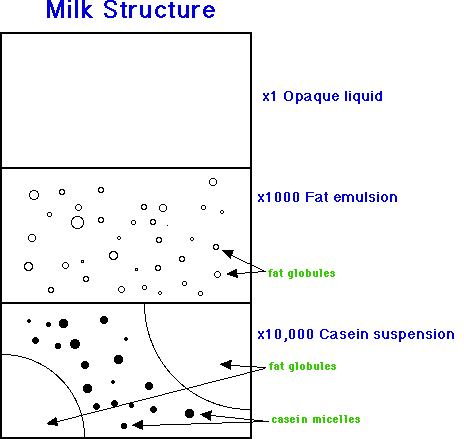Dairy Chemistry and Physics
7 Composition and Structure: Overview
The role of milk in nature is to nourish and provide immunological protection for the mammalian young. Milk has been a food source for humans since prehistoric times; from human, goat, buffalo, sheep, yak, to the focus of this section – domesticated cow milk (genus Bos). Milk and honey are the only articles of diet whose sole function in nature is food. It is not surprising, therefore, that the nutritional value of milk is high. Milk is also a very complex food with over 100,000 different molecular species found. There are many factors that can affect milk composition such as breed variations (see introduction), cow to cow variations, herd to herd variations – including management and feed considerations, seasonal variations, and geographic variations. With all this in mind, only an approximate composition of milk can be given:
- 87.3% water (range of 85.5% – 88.7%)
- 3.9 % milkfat (range of 2.4% – 5.5%)
- 8.8% solids-not-fat (range of 7.9 – 10.0%):
- protein 3.25% (3/4 casein)
- lactose 4.6%
- minerals 0.65% – Ca, P, citrate, Mg, K, Na, Zn, Cl, Fe, Cu, sulfate, bicarbonate, many others
- acids 0.18% – citrate, formate, acetate, lactate, oxalate
- enzymes – peroxidase, catalase, phosphatase, lipase
- gases – oxygen, nitrogen
- vitamins – A, C, D, thiamine, riboflavin, others
The following terms are used to describe milk fractions:
- Plasma = milk – fat (skim milk)
- Serum = plasma – casein micelles (whey)
- solids-not-fat (SNF) = proteins, lactose, minerals, acids, enzymes, vitamins
- Total Milk Solids = fat + SNF
Not only is the composition important in determining the properties of milk, but the physical structure must also be examined. Due to its role in nature, milk is in a liquid form. This may seem curious if one takes into consideration the fact that milk has less water than most fruits and vegetables. Milk can be described as:
- an oil-in-water emulsion with the fat globules dispersed in the continuous serum phase
- a colloid suspension of casein micelles, globular proteins and lipoprotein particles
- a solution of lactose, soluble proteins, minerals, vitamins other components.
Looking at milk under a microscope, at low magnification (5X) a uniform but turbid liquid is observed. At 500X magnification, spherical droplets of fat, known as fat globules, can be seen. At even higher magnification (50,000X), the casein micelles can be observed. The main structural components of milk, fat globules and casein micelles, will be examined in more detail later.


